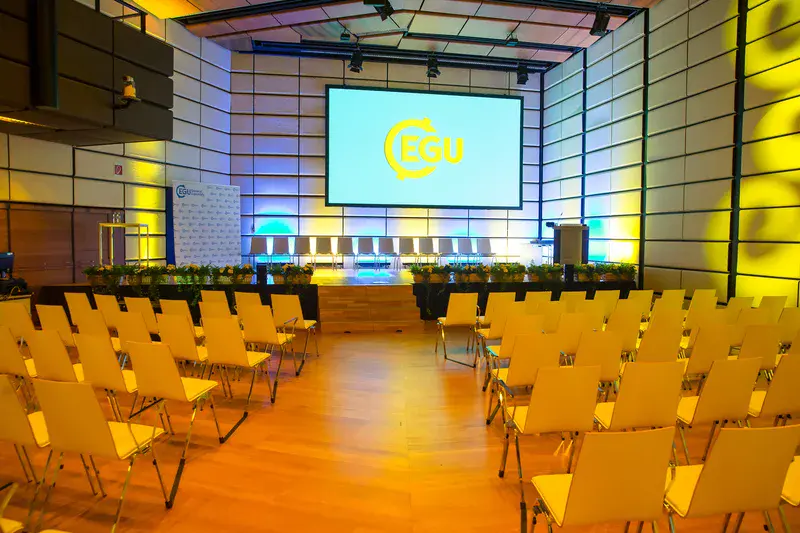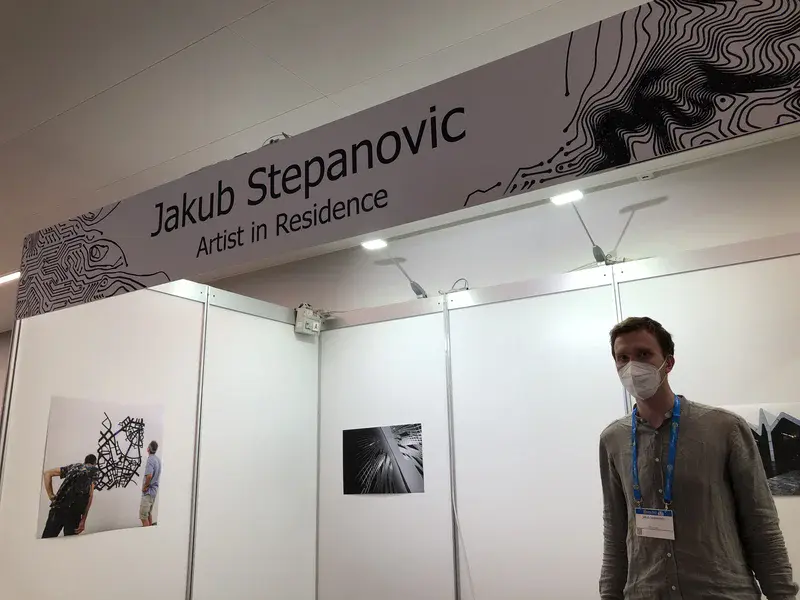
Highlights at a glance
- 08:30 – Mind your Head: mental health and the academic working environment SC1.3 Room -2.85/86; Where is my data, where did it come from and how was it obtained? Improving Access to Geoanalytical Research Data. GDB4: Room E1; How to Find Funding SC2.3 Room -2.61/62;
- 10:20 – European Research Council (ERC) Funding Opportunities in Geosciences SC2.4 Room -2.61/62; Geology 101 – The (hi)story of rocks SC4.3 Room -2.85/86
- 13:20 – Geoethics in the face of global anthropogenic changes: how do we intersect different knowledge domains? EOS4.1 Room 1.14; ADVANCEGeo Workshop – Strategies for Improving Workplace Climate in the Geosciences SC2.5 Room -2.61/62; Advances in fiber-optic sensing technologies for geophysical applications SM2.1/ERE5/GI5/NP8/OS4/TS4 Room -2.16
- 15:10 – Analogue and numerical modelling of tectonic processes TS9.1/GD9/GM9 Room D1; How to get involved with EGU SC1.2 Room -2.85/86
- 17.00 – Scientific neo-colonialism: what is it and why should you care? US4 Room E1; Meet the EGU Journal Editors SC3.10 Room -2.61/62

The future of (geo)scientific conferences
The COVID-19 pandemic has strongly expedited the evolution of scientific conferences, as numerous learned societies were forced to organize virtual meetings. EGU has thus needed to very rapidly change the format of the 2020 General Assembly from a traditional in-person meeting to “Sharing Geoscience online”, and organize vEGU21 as a fully virtual meeting, while EGU22 is the first hybrid meeting in the history of the Union. This Union Symposium will bring together meeting organizers and members of the community who have presented thoughts about future meetings to reflect on the required and desired evolution of scientific conferences, with a focus on the geosciences.
US3: 13:20–16:40 (CEST) Room E1
Medal lectures
- Milutin Milankovic Medal Lecture by Hai Cheng (MAL23 08:30–08:40 (CEST) Room 0.14)
- Marie Tharp Medal Lecture by Francesca Funiciello (MAL22 08:45–08:55 (CEST) Room D1)
- Alfred Wegener Medal Lecture by Günter Blöschl ‘Understanding changing river flood hazards’
(MAL1 10:20–11:50 (CEST) Room E1) - Arne Richter Award for Outstanding ECS Lecture by Jakob Zscheischler (MAL3 15:15–15:22 (CEST) Room 1.31/32)
- Angela Croome Award Lecture by Robin George Andrews ‘Fire and Ink: The Joy of Volcanic Storytelling’ (MAL7 19:00–20:00 (CEST) Room E1)
- Augustus Love Medal Lecture by David Bercovici ‘Searching for the origin of plate tectonics, leaving no grain unturned’ (MAL9 19:00–20:00 (CEST) Room D3)
- Beno Gutenberg Medal Lecture by Yehuda Ben-Zion ‘The Deep Roots of Geology: Tectonic History of Australia as expressed by Mantle Anisotropy’ (MAL10 19:00–20:00 (CEST) Room K2)
- David Bates Medal Lecture by Emma J. Bunce ‘Magnetosphere-Ionosphere Coupling and Aurora at Jupiter and Saturn’ (MAL11 19:00–20:00 (CEST) Room 1.85/86
- Fridtjof Nansen Medal Lecture by Monika Rhein ‘On the North Atlantic Circulation’ MAL12 19:00–20:00 (CEST) Room F2)
- Hannes Alfvén Medal Lecture by David J. McComas ‘Our Heliosphere and its Interstellar Interaction: A Solar Cycle of Global Observations and Discoveries‘ (MAL13 19:00–20:00 (CEST) Room L1)
- John Dalton Medal Lecture by Martha C. Anderson ‘On the value of thermal infrared remote sensing for water and land management’ and Arne Richter Award for Outstanding ECS Lecture by Niko Wanders ‘Dry drier drought – Understanding drought in a changing society and climate’ (MAL18 19:00–20:00 (CEST) Room B)
Short courses
- Mind your Head: mental health and the academic working environment SC1.3 08:30–10:00 (CEST) Room -2.85/86
- How to Find Funding SC2.3 08:30–10:00 (CEST) Room -2.61/62
- European Research Council (ERC) Funding Opportunities in Geosciences SC2.4 10:20–11:50 (CEST) Room -2.61/62
- Geology 101 – The (hi)story of rocks SC4.3 10:20–11:50 (CEST) Room -2.85/86
- Using Copernicus data for Atmospheric Composition Applications SC5.10 10:20–11:50 (CEST) Pre-recorded
- ADVANCEGeo Workshop – Strategies for Improving Workplace Climate in the Geosciences SC2.5 13:20–14:50 (CEST) Room -2.61/62
- Effective gridded spatial data aggregation and analysis with Discrete Global Grid Systems on the example of Uber H3 SC5.9 13:20–14:50 (CEST) Pre-recorded
- Deriving soil moisture information with optical remote sensing data in R SC5.15 13:20–14:50 (CEST) Room -2.85/86
- How to get involved with EGU SC1.2 15:10–16:40 (CEST) Room -2.85/86
- Careers inside and outside of academia: Panel Discussion SC2.2 15:10–16:40 (CEST) Room -2.61/62
- Crafting beautiful maps with PyGMT SC5.2 15:10–16:40 (CEST) Pre-recorded
- Outreach: how to get your science out there? SC3.7 17:00–18:30 (CEST) Room -2.85/86
- Meet the EGU Journal Editors SC3.10 17:00–18:30 (CEST) Room -2.61/62
- Introduction to time series analysis for Earth scientists SC4.15 17:00–18:30 (CEST) Pre-recorded
- Lewis Fry Richardson Medal Lecture by Ulrike Feudel ‘Tipping phenomena and resilience of complex systems: Theory and applications to the earth system’ (MAL20 19:00–20:00 (CEST) Room 0.94/95)
- Plinius Medal Lecture by Slobodan Nickovic ‘Numerical prediction of the atmospheric dust process: the way to reduce risks from its adverse effect’ (MAL25 19:00–20:00 (CEST) Room 1.61/62)
- Robert Wilhelm Bunsen Medal Lecture by Janne Blichert-Toft ‘When Geochemistry encounters Archaeology’ and Arne Richter Award Lecture for Outstanding ECS Lecture by Fabian B. Wadsworth ‘A reappraisal of explosive-effusive silicic eruption dynamics’ (MAL27 19:00–20:00 (CEST) Room D2
Geoethics in the face of global anthropogenic changes: how do we intersect different knowledge domains?
How can geosciences address global anthropogenic changes, such as climate change, hazards and risks, natural resources exploitation? And where do ethics fit in? These fundamental questions are posed and discussed in this session co-sponsored by the American Geophysical Union (AGU), CIPSH – International Council for Philosophy and Human Sciences, and IUGS – International Union of Geological Sciences.
EOS4.1 Presentations / 13:20–16:34 (CEST) Room 1.14
Where is my data, where did it come from and how was it obtained? Improving Access to Geoanalytical Research Data.
Data is at the backbone of our research discussions, conclusions and solutions to problems nature presents us with, but one of the greatest challenges pertaining to analytical research is to collate, store and make these data publicly available in standardised and machine-accessible form. This Great Debate puts the questions, problems, challenges and opportunities around geoanalytical research data to the center stage at EGU, a topic researchers from almost every scientific division are concerned with.
GDB4: 08:30–10:00 (CEST) Room E1

Meet our Artists in Residence – Jacob Stepanovic
Jakub Stepanovic (@jakubstepanovic) is an interdisciplinary mixed-media artist, sculptor and communicator, with a background in photojournalism who creates images and installations focused on the ideas of maps, navigation and exploration. At the General Assembly he will work with various data and images to create two-dimensional artwork examining how researchers approach maps and landscapes, and how they link to memories and emotions. Head over to his booth in the Entrance Foyer and speak to him about how you can creatively capture and visualise your data.
Measuring space weather condition with geomagnetic data
This session focuses on the use of geomagnetic data (from ground observatories to satellites such as CHAMP, Swarm, CSES, ePOP and others) as a tool to gain insight both into the physics of the processes involving the Earth’s magnetic field in response to space weather events and into their effects as the degradation of satellite signal, perturbation in radio communications, and disruption of power system devices.
EMRP2.15/ST4 Presentations /15:10–18:30 (CEST) Room -2.31
Advances in fiber-optic sensing technologies for geophysical applications
Discover recent breakthroughs in the use of fiber-optic sensing techniques to interrogate cables at high precision both on land and at sea. Laser reflectometry using both fit-to-purpose and commercial fiber-optic cables have detected a range of seismic signals, while others are used to monitor temperature and chemicals at scales previously unattainable with conventional geophysical methods.
SM2.1/ERE5/GI5/NP8/OS4/TS4 Presentations 13:20–17:23 (CEST) Room -2.16
Analogue and numerical modelling of tectonic processes
Geologic processes are generally too slow, too rare, or too deep to be observed in-situ and to be monitored with resolutions high enough to understand their dynamics. This session showcases state-of-the-art analogue and numerical/analytical models on various spatial and temporal scales, from earthquakes, landslides and volcanic eruptions to sedimentary processes, plate tectonics and landscape evolution.
TS9.1/GD9/GM9 Presentations / 15:10–18:24 (CEST) Room D1
Biogeochemistry of coastal seas and continental shelves
This session aims to share learnings of the roles of coastal environments and of exchange processes, both natural or perturbed, along the terrestrial / coastal sea / open ocean continuum in global biogeochemical cycles. Contributions focusing on carbon, nutrients and other elements’ cycles in coastal, shelf and shelf break environments, both pelagic and sedimentary, are invited.
BG4.2/OS3 Presentations / 08:30–11:49 (CEST) Room 3.16/17
Scientific neo-colonialism: what is it and why should you care?
Scientific neocolonialism is unfair to the local scientific communities, who may contribute to the work without being recognized nor treated as equal partners. In addition, the scientific interpretations resulting from such approaches may suffer from the lack of local knowledge – which could prevent wrong hypothesis or extrapolations. This Union Symposium aims to shed light on various examples of scientific neo-colonialism, how EGU members can have significant impact, and how inclusion in global research can lead to better science.
US4: 17:00–18:30 (CEST) Room E1
Ice clouds observations and modelling
Ice and mixed-phase clouds play an important role in the Earth’s radiation budget because of their high temporal and spatial coverage. Yet, the variability and complexity of their macro- and microphysical properties makes their study extremely challenging. This session aims to advance our understanding of ice clouds by bringing observation- and modelling-based research together.
AS1.15 Presentations / 08:30–11:50 (CEST) Room M1
ESA Living Planet Symposium 2022
CM22 Plenary
As a world leader in Earth observation, Europe is bound to use this pole position to help address the climate crisis and ensure that the value of observing Earth from space benefits society, the economy, the commercial world and more. With ESA’s Ministerial Council taking place in November, this session not only allows the audience to hear about the Earth observation proposals being tabled, but also allows for a broad exchange to help the Executive fine-tune their plans for the future
Future Earth Observation – Pioneering world-class science missions for Earth
This session focuses on ESA’s core Earth Observation research and development programme, FutureEO. Paving the way for future activities, FutureEO harnesses novel ideas to develop pioneering satellites. In turn, allowing scientific excellence to flourish, which is critical to addressing environmental challenges of tomorrow and instrumental to boosting societal and economic resilience. The audience can hear about the way this key programme retains Europe as a world-leader in all aspects of observing Earth from space and, importantly, what’s next.
Watch the CM22 Plenary, live from EGU22: 09.00-12.45 (CEST) and Future Earth Observation 14.00-17.00 (CEST), live in Hall A
JpGU at EGU22: Landslides and related phenomena
Landslides, such as rockslides, rockfalls, and debris flows, have been occurring extensively in a large number of countries, typically Asian countries, causing heavy damage. Landslides have been studied in various research fields, such as geomorphology, geology, geophysics, Sabo engineering, geotechnics, but we need a common platform to exchange research results and make discussion to strengthen our activity. In this session authors will discuss landslides and related phenomena, focusing on improving understanding of their characteristics; new insights into landslide mechanisms; the development of new approaches to monitoring; novel approaches to behavior forecasting and prediction; studies of successful landslide management; and the development of methods for hazard and risk evaluation.
Further details on the JpGU website.
JpGU1 02:00–08:15 (CEST), also in Hall X5
About
EGU Today helps you keep up with the many activities at the General Assembly by highlighting sessions and events from the programme. If you have comments, email the editor Hazel Gibson at communications@egu.eu. The newsletter is available at https://www.egu.eu/egutoday/ and on screens around the conference centre.
The Assembly Online
LinkedIn
Instagram
YouTube
Facebook
Mastodon
Bluesky
blogs.egu.eu, geolog.egu.eu
www.egu.eu